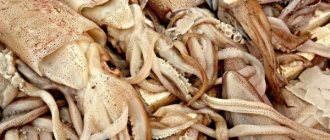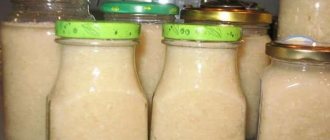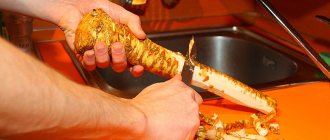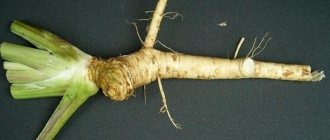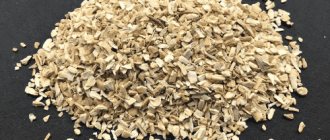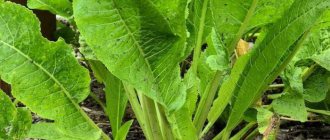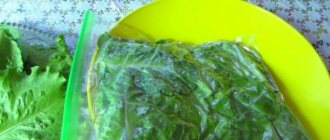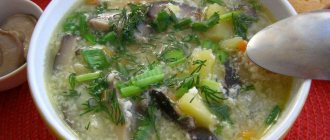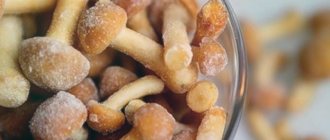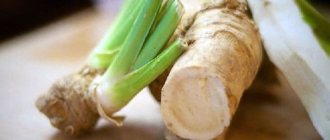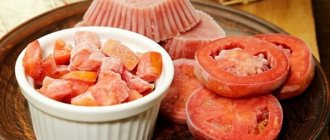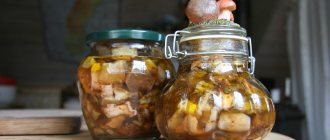Description of the plant
Horseradish is a herbaceous perennial plant belonging to the Brassica family. It grows under natural conditions in Europe, Siberia and the Caucasus, was brought to the countries of the Asian and American continents and is quite widely cultivated there. Wild forms of horseradish are often found along the banks of rivers, lakes and swamps. They have reclaimed vacant lots and landfills, as well as the backyards of vegetable gardens.
Although horseradish is considered a cultivated herb, it can often be seen growing in wild places, such as riverbanks and swamps.
Horseradish can grow up to one and a half meters in height, has an erect branched stem, elongated basal leaves, and a large, fleshy root. Small, white inflorescences form fluffy clusters. Horseradish seeds ripen in small pods.
Photo gallery: leaves, flowers and horseradish root
Horseradish leaves are large, oval, long-petiolate, oblong, serrated along the edge
Horseradish has a powerful, thick, fleshy rhizome
Horseradish blooms with small white flowers collected in racemes
A little history
The nutritional and medicinal properties of the plant were known back in the Ancient world. In Rus', horseradish has been grown presumably since the 9th century. There is a laudatory entry about this plant in the Russian Herbalist. The ancient Slavs used horseradish for eye diseases and to increase love. In the Middle Ages, the crop began to be grown in Western European countries. As a spice, it became popular in Germany and the Baltic countries, and the British grew horseradish for medicinal purposes.
Application
Horseradish is used as a spicy addition to many dishes; marinating and salting vegetables and mushrooms, sauerkraut, and preparing drinks (kvass, horseradish) cannot be done without it. Seasonings with grated horseradish root can be served with almost any dish: ham, fried and boiled meat, sausages and sausages. Horseradish with sour cream or apples perfectly complements fish dishes. They eat cottage cheese with it and prepare dressings for vegetable salads.
Horseradish seasoning goes well with poultry aspic, cold boiled beef, veal and beef offal
Horseradish has long been actively used in folk medicine. The antibacterial properties of horseradish root juice are known, so it is used for colds, rinsed the mouth and throat for sore throat (tonsillitis), and helps with toothache.
Horseradish root juice is used to make homemade tinctures
Horseradish decoction has a diuretic and vasodilating effect, so it can be used for hypertension and vascular atherosclerosis. Compresses and lotions made from root pulp are effective for ear inflammation, radiculitis, bruises and fungal skin lesions. The whitening properties of horseradish are also known and are actively used in cosmetology. Root tincture is used to remove freckles, unwanted tanning, and age spots on the skin.
Video: beneficial qualities of horseradish, popular recipes
Interesting fact! In the United States of America, horseradish is classified as a particularly important product for medicine, defense and the space industry.
Types and varieties of horseradish
In Russia, horseradish is rarely cultivated on an industrial scale, so of the many (about 500) previously existing varieties, only a few remain in modern gardens.
It is interesting to know that in Europe, where horseradish spread in the Middle Ages, more than 2 thousand varieties of this plant have been bred. In America, where it was brought in 1900, there are already 3.5 thousand.
In summer cottages, local wild forms of horseradish are most often cultivated. But there are also cultivated varieties, one of which, Atlant, is included in the State Register of Breeding Achievements approved for use on the territory of the Russian Federation as a mid-season variety. Atlas has a long (up to 50 cm), rather thick (up to 5 cm in diameter) grayish-white root. Its weight can reach 380 g, it has dense milky pulp. The plant does not bloom and propagates only by cuttings. The variety shows good keeping quality and high commercial qualities, resistance to heat, drought and frost, is universal in use and recommended for cultivation in all regions of Russia, as well as in Belarus, Ukraine and Moldova.
The rhizome of horseradish variety Atlant is smooth, whitish-gray, with a small number of tubercles
Among the varietal forms of horseradish the following can be mentioned:
- Valkovsky. A late-ripening variety with a yellowish cylindrical root and milky-white pulp. Its weight can reach 150 g, length - 60 cm, and the diameter of the middle part - 3 cm.
- Suzdal. For centuries, the variety was grown in the vicinity of Suzdal and was considered the most vigorous, juicy and fragrant. Annual roots up to 30 cm long, which have practically no side shoots, are valued. In older rhizomes, there is a lack of tenderness and juiciness.
- Tolpukhovsky. A late-ripening variety with a white-grayish cylindrical rhizome about 35 cm long, about 3 cm in diameter, weighing up to 250 g, with white pulp. It is unpretentious, tolerates frost and lack of moisture well, so it is often grown for greens, leaving the roots in the ground for the winter.
Helpful information! Russian gardeners grow the Alpo (Polish selection) and Malinsky (Czech selection) varieties on their plots, but many consider them not vigorous enough.
Katran and wasabi are relatives of horseradish
Horseradish, katran and wasabi are biological relatives, as they belong to the same Brassica family. The last two vegetables can be called substitutes for horseradish, since they are similar to it in nutritional and taste benefits.
The perennial herbaceous plant katran has a powerful (up to 10 cm in diameter) root with white pulp, which contains many essential oils. The yield of root crops is 1.2–1.8 kg/sq. m, the plant is drought and frost resistant. Katran, like horseradish, is rich in minerals and vitamins. Its advantage is the shape of the roots, which is convenient for processing, as well as the lack of aggressiveness in clogging the area.
Along with the root, young katran leaves are successfully used in vegetable salads as an analogue of asparagus
Wasabi, or Japanese eutrema, is also called mustard green or Japanese horseradish. It is also an herbaceous perennial with a high content of essential oils that have a horseradish scent. The Japanese believe that real wasabi grows only in running water from mountain streams. The garden crop of the same name has only the smell and taste of genuine Japanese eutrema.
For normal growth and development of Japanese eutrema, a moderately warm climate is required with year-round air temperatures ranging from +7 to +22 ºС
Reviews about katran
I would recommend growing not horseradish, but steppe katran (Tatar). It tastes the same as horseradish (even better), but the roots are much thicker, smoother, meatier, and seem to be non-fibrous and DO NOT clog up the garden. In the first year after sowing, the root thickness is up to 2 cm, in the second up to 7 cm in diameter, in the third it blooms and dies along with the root. Therefore, you don’t have to be afraid that it will grow in the garden and you won’t be able to remove it.
Mmm
https://forum.vinograd.info/showthread.php?t=13527&page=2
My grandmother grew katran. It used to be quite popular, but over time people began to plant horseradish instead. But it seems to me in vain. Katran, unlike horseradish, does not spread all over the area; the taste of the root is more delicate and pleasant. I sow it in the fall; after several spring plantings, the seeds never sprouted. They probably need to be in the cold to germinate. I don’t dig it up for the first year, although in principle you can put the young roots into food, they are already tasty. But it’s better to wait a year for them to grow bigger. In the second year I dig it up, but not all of it. A couple of rhizomes will definitely overwinter in the garden bed again so that the seeds can be collected next year. By the way, you can also eat the leaves of the katran plant. But they are not for everyone. I don’t like it, but my neighbor happily breaks off the young leaves and puts them in salads.
Artemida
https://chudo-ogorod.ru/forum/viewtopic.php?f=55&t=2028
Katran is a little more difficult to grow than regular horseradish and has more pests.
tanja
https://www.tomat-pomidor.com/forum/ogorod/%D0%BA%D1%82%D0%BE-%D1%81%D0%B0%D0%B6%D0%B0%D0%BB- %D0%BA%D0%B0%D1%82%D1%80%D0%B0%D0%BD-%D0%B0%D0%BD%D0%B0%D0%BB%D0%BE%D0%B3- %D1%85%D1%80%D0%B5%D0%BD%D0%B0/
How does horseradish reproduce?
Cultivated forms of horseradish do not flower, so they can only be propagated vegetatively, that is, by root petioles obtained from lateral roots or thin (about 1 cm in diameter) annual rhizomes. They are cut into cuttings about 20 cm long. The upper part of the cutting is cut straight, and the lower part - obliquely. Such sections allow you to correctly navigate when planting - to determine the top and bottom of the petiole.
Roots no larger than 8 mm in diameter are taken for cuttings and stored in sand until spring.
Planting material is best harvested in the fall during harvest. The cuttings are tied into bunches and stored in the cellar or buried with earth. A month before planting, they are placed in a warm room. Immediately before planting, it is recommended to blind the petioles by removing dormant buds. To do this, wipe the middle part of the petiole with burlap, without touching the top and bottom of the root.
Helpful advice! If planting material was not harvested in the fall, then in the spring this must be done as early as possible before the leaves appear.
For propagation, apical buds can be used. They are cut off together with a small (2–3 cm) piece of root, dried and planted in a light substrate for germination.
The apical part can be harvested in winter using roots stored in the refrigerator or basement
Growing horseradish in open ground
A high-quality horseradish harvest is to obtain a well-developed, smooth, thick and straight root. This result is obtained only if horseradish is grown as an annual crop. Perennial roots become woody, branch, become small and tasteless.
Horseradish planting
The soil for planting the crop is dug deeply and carefully, otherwise the roots of the plant will branch heavily. When digging, add humus (half a bucket per square meter), superphosphate and potassium chloride (50 g and 20 g for the same area, respectively).
Since horseradish is a cold-resistant crop, cuttings are planted in April along with early vegetables. When the soil is properly moistened, planting is done in furrows, and when there is excess moisture, in ridges. The cutting is placed at an angle so that its upper part is covered with a layer of soil of 4–5 cm, and the lower part is at a depth of at least 10 cm. When planting, a distance of 30–40 cm is maintained between plants, and about 70 cm between furrows or ridges .
The horseradish stalk must be planted at an angle so that the upper part of the root is buried 5 cm and the lower part 10 cm.
Caring for horseradish plantings
The opinion that horseradish does not need the attention of gardeners is erroneous. When growing this crop, it is imperative to follow standard care measures.
- Since horseradish has large leaves that evaporate a lot of water, and the root system has a weak absorption capacity, the crop needs watering throughout the season. If there is a lack of moisture, the horseradish leaves will wither, and the rhizome may turn out to be rough and fibrous. If the soil is over-moistened, the roots rot.
- Weeding and loosening the soil help deliver oxygen to the roots.
- If the soil is well-dressed, fertilization of the crop may not be necessary. Otherwise, monthly complex fertilizing is desirable (20 g of urea, 40 g of superphosphate and 15 g of potassium chloride per 1 sq. m), starting from the stage of rooting and opening of the first leaves, until the end of the season.
When growing horseradish in small volumes, a specific root cleaning procedure is carried out. It consists of the following:
- When the horseradish tops reach a height of 15 centimeters - this is approximately the beginning of July - the soil is raked away from the roots.
- Having exposed the root to about 20–25 cm, all lateral roots and branches are removed from it. The lower root bud is not touched.
- The rhizome is covered with earth, which is thoroughly compacted and watered.
In July, plants are carefully dug up to clear the main root from lateral branches.
The root treated in this way grows especially large and even. At the same time, it is recommended to remove excess rosettes from the plant, leaving no more than two.
Growing horseradish on the site
Growing horseradish on your own plot is an economic necessity. It’s so convenient to have a fresh leaf of horseradish on hand for pickling and not have to run to the market to get it.
Horseradish is a perennial plant with thick, well-developed roots and large oblong leaves. In fact, although horseradish can grow in one place for many years, it is still better to grow it as an annual crop.
Simply put, you need to plant it in the spring and harvest it in the fall, getting marketable roots in one year. Long-term cultivation of horseradish is undesirable, since in the second year the roots begin to become woody, branch strongly, and become smaller, as a result of which they become unsuitable for food.
All kinds of seasonings for meat and fish dishes are prepared from horseradish roots and used for pickling vegetables and pickling.
Horseradish contains a large amount of vitamin C, B2, B6, B8, B9, PP and allylic mustard oil, which gives horseradish its pungency and special smell. Horseradish leaves also contain a high content of carotene.
Horseradish promotes the secretion of gastric juice, which helps improve the digestion process. Traditional medicine uses horseradish to treat radiculitis and sore throat.
Horseradish successfully overwinters in the ground and produces almost no seeds, so propagation of horseradish occurs by root cuttings. Growing horseradish should begin with taking cuttings.
Cuttings for planting horseradish can be harvested in the spring. But in this case, the roots need to be dug up early, as soon as the snow melts, and planted immediately.
If you don’t have your own planting material, then you can buy horseradish roots, cut it into pieces 3-4 cm long and plant them in the ground in early spring. By autumn, growths form on the roots from which planting material of normal size can be formed.
They need to be planted in spring on cuttings in ridges or beds on a fertile area well fertilized with organic matter. Horseradish loves loamy or sandy soils.
The process of growing horseradish should occasionally be accompanied by the application of fertilizers.
In the fall, it’s a good idea to apply 1.5 buckets of compost or manure per 1 m2 of planting under horseradish and add more mineral fertilizers - about 50 g of superphosphate and up to 20 g of potassium chloride.
If the soil is highly acidic, then it must be limed.
All fertilizers can be applied with a shovel to the depth of its bayonet. This depth, in principle, corresponds to the depth of the humus layer.
It is best to use annual roots from 20 to 30 cm long and about 1 cm thick for growing horseradish. It is important not to confuse the upper and lower parts of the roots. To do this, the lower part of the cuttings must be cut obliquely.
It is advisable to place 5 rhizomes per 1 m2. Before planting horseradish cuttings, it is necessary to remove excess lateral buds from them, leaving only the buds in the upper and lower parts of the cuttings, so that horseradish roots and leaves have something to develop from.
In early spring, horseradish rhizomes need to be planted in the ground. As already mentioned, it is better to plant horseradish on a ridge. The distance between the ridges should be about 70cm.
You need to make inclined holes with a peg, put the cuttings in them so that they do not reach the level of the bed or ridge by 2 - 3 cm and cover them with earth.
The cuttings should be placed at an angle of 30 degrees, the distance between them should be 35 cm. The cuttings need to be pressed with soil to create close contact with the ground.
Before planting, you should get rid of excess buds (along the length of the cutting) so that lateral roots cannot develop. The buds must be saved from both ends of the cutting. These produce leaves from the upper end and roots from the lower end.
Caring for horseradish consists of loosening, weeding and finishing. Finishing consists of the following: 60 days after planting, you need to dig up the roots and cut off the side roots of the main root, leaving only the lower ones. It is advisable to carry out finishing on cloudy days.
If horseradish is planted on ridges, then during the summer it needs to be hilled several times. Well, it’s a good idea to feed it with fertilizers a couple of times during the summer. Per 1m2 you can add 15-20g of potassium chloride, 50g of superphosphate and about 20g of urea.
Horseradish cultivation is almost over when the harvesting season begins.
Horseradish harvesting actually begins already in July, when the pickling season begins. They tear horseradish leaves for pickling and pickling cucumbers - lightly salted and for the winter and tomatoes, and dig up the roots.
Horseradish roots are harvested in late autumn, before the ground freezes, or in spring before the leaves appear. In autumn, first of all, you need to cut off the leaves, and then dig up the roots and carefully select them.
Horseradish dug up in the fall should be tied into bunches and stored in the basement in damp sand, or you can dig it in the garden. If your rhizomes are biennial, then one-year growths should be cut off from thick roots.
By the way, you need to choose the roots carefully if you don’t want to fight horseradish later as a nasty weed.
From 1m2 you can collect up to 2kg of product. Thick roots are used for food: for making seasonings and pickling vegetables. Thin roots with a diameter of 0.8 - 1.5 cm should be saved for planting in the basement, buried in the sand. It is better to discard roots with a diameter of less than 0.5 cm, as they are of little use for planting.
If you follow all these recommendations, then growing horseradish will give you pleasure and will not turn into tedious weed control. You might also be interested in an article about the variety of varieties of parsley.
Read Gardening and an excellent harvest is guaranteed.
Previous article: The most common varieties of parsley Next article: Growing physalis in a personal plot
Send to your social network so as not to lose:
Rate this article:
Horseradish instead of ficus
It’s great if the housewife always has fresh herbs on hand. At any time you can pick parsley, dill and make a sandwich with green onions. These plants thrive not only outdoors, but also in pots on the windowsills and balconies of city apartments. Horseradish can be grown in the same way. What is needed for this:
- large planting capacity: a tub or pot for ficus is perfect;
- soil: you can buy it in a specialized store or bring it from the garden;
- horseradish cuttings.
The rules for planting and caring for horseradish when grown indoors are similar to those for open ground farming. And if you take into account the unpretentiousness of the culture and the normal tolerance of shading, then with minimal care you will get excellent greens that can be added to soups and salads. Lightly salted cucumbers cooked with horseradish leaves will be appreciated by your family and guests in winter. Green leaves and roots of horseradish are useful for treating colds and other diseases.
Good to know! A tub of planted horseradish will decorate your apartment. Its large, bright green, expressive leaves grow quickly and look no worse than those of ficus.
The tub is filled with soil mixed with compost, holes are dug inside and the roots are planted.
It is also possible to grow crops in planting containers (barrels, large boxes) that limit the spread of roots in the countryside. In this case, the main problem is eliminated, because of which many are afraid to plant horseradish - its massive spread throughout the site. And autumn harvesting is simplified to a minimum: just turn the container over and shake out its contents.
How to grow horseradish
Despite the fact that horseradish is considered an aggressor, which, after an unsuccessful move by a cultivator of one bush, spreads throughout the entire garden, it is a rather whimsical plant. Horseradish becomes an unmanageable weed when they stop caring for it and, without digging it up, leave it to grow in one place for longer than three years.
To prevent horseradish from spreading throughout the area, it is dug up in the fall and replanted with cuttings in the spring.
Horseradish loves fertile soil and grows best on loam: on sandy soil the roots do not have enough moisture and they become “woody”; Heavy soil is also not suitable; it is in it that the horseradish roots become branched and rough.
Horseradish loves good watering, but can die from excess moisture.
Horseradish does not grow well in acidic soils.
Possible problems when growing horseradish
Horseradish is a persistent crop. Due to the large amount of mustard oils, its leaves are not eaten by domestic and wild animals. But problems when growing horseradish can still arise in the form of:
- pest attacks,
- fungal diseases to which horseradish is susceptible,
- consequences of non-compliance with agricultural cultivation techniques.
Horseradish pests
Horseradish has many enemies among six-legged pests. To prevent insects from entering the garden, you need to take basic preventive measures:
- carry out deep digging of soil,
- in the fall, remove and destroy plant debris,
- remove weeds in a timely manner.
Cabbage leaf beetle, or cabbage leaf beetle
It is considered the main enemy of horseradish. This small (3–4 mm) dark green beetle, as well as its larvae, are capable of destroying all the pulp of the leaf blade, so that only thick veins remain on the leaf. The pest attacks plants in early June, at which time the females lay eggs in holes gnawed out on the leaves, and a new generation of beetles again harms the plant in August.
The female moth lays up to 400 eggs in holes gnawed in the leaf tissue along the veins, and seals them on top with special secretions, which protects them from drying out.
If holes are found on horseradish leaf plates, they are carefully inspected. When pests are identified, the following measures are taken:
- manual collection of beetles and larvae;
- removing damaged leaves;
- treatment with a dry mixture of wood ash (1 cup), dry mustard (1 tsp) and ground red pepper (1 tsp). Pollination with this composition must be carried out three times with an interval of 5–6 days;
- In case of mass damage, treatment with insecticides is used: Actellik, Karbofos, Inta-Vir.
Wavy flea beetle
Despite its small size (3 mm), this bug can cause enormous harm to horseradish. The attack occurs in early spring. A microscopic bug eats through holes in horseradish leaves. As a result of loss of green mass, the plant becomes sick and may die. Females lay eggs on the surface of the ground.
The wavy flea beetle can be recognized by its black color and yellow stripes on the elytra.
Effective means to combat the wavy flea beetle:
- plant insecticides containing tobacco;
- dry mixture of mustard, pepper and ash (see recipe above);
- sticky traps made of honey and grease, which are applied to horseradish leaves;
- When the pest spreads massively, it is necessary to use chemicals: Actellik, Foxim.
Remember! When working with chemicals, it is necessary to observe personal safety measures: carry out processing in calm weather, use gloves, protect your face with goggles and a mask.
Cabbage moth
This is a small butterfly with a wingspan of about 3 cm. Its flight begins in June, and after a couple of weeks, voracious caterpillars emerge from the laid eggs and gnaw on horseradish greens. In August they pupate and overwinter in the ground, only to attack plants again in early summer. In case of small numbers of pests, they can be collected manually, but in case of mass lesions, it is necessary to treat the plants with antiparasitic insecticides.
Cabbage moth is a small brownish butterfly with dark stripes on the front wings.
Cabbage bug
The leaves of the plant will signal that horseradish is affected by this pest. They will begin to turn yellow and subsequently become covered with dying spots. The pest becomes active in early summer. The bug larvae and adults that have appeared by this time suck the juice from the leaf blades and shoots. As a result, the green part of the plant may die, and the plant will not produce the expected harvest.
In addition to the above-mentioned preventive measures, pollination with tobacco dust mixed with sand or treating the leaves with a soap solution (300 g of laundry soap per bucket of water) will help repel the pest. If, upon visual inspection, several parasites are found on each plant, then it is necessary to treat the horseradish bushes with insecticides (Atellik, Fosbecid, Belofos).
An adult bedbug has a flat, red body with black spots.
Important! If horseradish leaves have been treated with chemicals, they can be eaten no earlier than a month after spraying.
Basic diseases of horseradish
In addition to pests, horseradish bushes can be affected by fungal diseases. Preventive measures to combat them are:
- compliance with crop rotation and planting rules,
- autumn cleaning and destruction of plant residues,
- timely weed control,
- deep digging of the soil.
Table: main horseradish diseases and methods of combating them
| Disease | Signs of defeat | Causes | Control measures |
| Ascochyta blight | Large brownish-yellowish spots on leaf blades. Drying and falling of leaves. |
|
|
| White rot | White coating on the leaves and rhizome of horseradish. |
| Destruction of diseased plants and treatment with copper-containing fungicides. |
| Belle or powdery mildew | A coating resembling white powder on leaves and shoots. | Failure to comply with preventive measures to remove post-harvest residues and dig up the soil where the pathogen overwinters. | Spraying with copper-containing preparations |
| Verticillium wilt | First the leaves, and then the whole plant, withers and dies. | Failure to comply with preventive measures to remove post-harvest residues and dig up the soil where the pathogen overwinters. | Removing diseased plants along with a layer of soil. |
| Downy mildew | Yellowish or light green spots on the leaves of the plant, a grayish coating on the back of the leaf blades. Subsequently, the leaves turn brown and die. |
|
|
Photo gallery: diseases of garden horseradish
White rot Powdery mildew
Ascochyta blight
External signs of problems when growing horseradish
The undemanding nature of the crop in terms of growing conditions, compliance with agrotechnical rules and regulations, as well as timely measures taken to prevent diseases are the main forms of protecting horseradish from possible problems. If they do occur, then the appearance of the plant will first of all signal this.
Important! It is necessary to periodically inspect horseradish plantings in order to notice the signals of the plant and take adequate measures in time.
Table: external signs of problems when growing horseradish and ways to solve them
| Description of the problem | Causes | Corrective measures |
| The horseradish has bloomed. This can happen in the second year after planting. Peduncles deplete the plant by drawing nutrients from the leaves and rhizomes. |
|
|
| Through holes on the leaves. | Pest attack:
|
|
| The horseradish leaves have turned yellow. |
|
|
| Spots on leaves. |
|
|
| Horseradish doesn't grow. | Unsuitable soil. | Horseradish prefers slightly acidic soil, so if necessary, the soil is powdered with powdered sulfur or, conversely, limed to reduce acidity. |
| Woody root vegetable. | The soil is heavily compacted. | Carry out deep autumn plowing and systematic loosening of the soil. |
| A coarse, branched root vegetable. |
|
|
| Flabby, tasteless root vegetable. | Low-nutrient sandy soil. |
|
Beneficial properties for the body
Thanks to its rich vitamin composition and essential oil, horseradish leaves help strengthen the immune system and help during the treatment of colds.
The leaves contain a large amount of minerals that are activated when heated, so horseradish can be used while going to the sauna to flavor the water. Thanks to this plant, steam in the bath becomes healing (helps improve overall well-being, mood, and also removes toxins).
Eating horseradish leaves reduces the risk of developing a disease such as scurvy, since the greens contain large amounts of ascorbic acid.
The leaves act as a medicine that helps in the fight against low acidity of gastric juice.
Women
Systematic consumption of horseradish leaves helps speed up metabolism and improve intestinal function, which in turn helps to get rid of excess weight.
Masks and compresses made from leaves help improve skin condition and get rid of age spots/freckles.
Men
The use of tinctures of horseradish leaves helps enhance male potency. The plant is a natural aphrodisiac, which improves sexual function.
Compresses from the leaves help relieve inflammation of the sciatic nerve, which often occurs in men with sedentary work.
Harvest and storage
Horseradish leaves can be cut throughout the season and used as additives in salads, first courses, and when pickling and pickling cucumbers and tomatoes. Complete harvesting is carried out in late autumn before the soil freezes (approximately at the end of October). It is by this time that the roots accumulate the maximum amount of nutrients and have good juiciness and taste. The signal for harvesting is yellowing and dying of leaves. Before harvesting, they are completely cut off, and then they dig up the bush with a pitchfork, take out the rhizome, and sort through the soil to remove all the remnants of the roots.
Important! It is better to clear the rhizome from the soil and cut it not in the garden, since in this case the area may become clogged with fragments of roots, which can germinate and clog the area in the spring.
Horseradish is a high-yielding crop. Approximately 1.5–2 kg of roots are obtained from one square meter. About 60% of them (with a diameter of 1.5 cm) can be used for storage and processing, the thinner ones (about 1 cm in diameter) are left for planting the next season. Roots of smaller diameter are unsuitable for use and go to waste.
Horseradish greens at room temperature retain their commercial qualities for three days. If you place it in a plastic bag and store it in the refrigerator, the shelf life will increase to three weeks.
Treated roots are immediately sent for processing and storage, otherwise they will lose their elasticity. Horseradish roots are stored in the basement, covered with sand. It is very practical to store dried horseradish, the powder from which is excellent for making sauces and seasonings. Drying can be done in natural conditions, or you can also use an electric dryer or oven.
Dried horseradish roots can be ground using a coffee grinder or food processor, grated on a fine grater or crushed in a mortar
Many housewives freeze the vegetable and use it as needed. When stored in the freezer, the nutritional properties of horseradish are preserved for six months.
How to preserve leaves for the winter?
To keep horseradish leaves on hand all year round, they need to be prepared in the summer. There are three ways to preserve the plant so that it does not lose its beneficial properties and taste: freeze, dry and preserve.
Freezing
Horseradish leaves need to be thoroughly rinsed under running water, then dried (with a towel or allowing the liquid to drain naturally). After this, the leaves need to be portioned out into plastic bags and placed in the freezer.
You can freeze both whole and chopped leaves. They do not need to be thawed before use, but added directly to the dish while frozen.
Leaves can be stored in the refrigerator for 10 to 12 months.
Canning
There is a simple way to preserve horseradish leaves. To do this, you need to prepare the jar, rinse it well and sterilize it. Wash the leaves in cold water and dry completely in a dark place out of direct sunlight. After this, the leaves need to be coarsely chopped using a sharp knife.
A thick layer of horseradish is placed on the bottom of the jar, sprinkled with salt on top, pressed down a little, and so on in a circle until the container is completely filled. Then the jar is sealed and stored in the refrigerator.
Drying
Only healthy horseradish leaves are used without inclusions or damage. First, the plant is thoroughly washed and dried from moisture (you can hang it on a rope or place it on paper towels).
After this, the leaves need to be chopped with a knife. Then the workpiece is transferred to a baking sheet covered with parchment and placed in an oven preheated to 45 degrees to dry for about 2 or 3 hours.
If desired, you can dry the leaves in the sun for 12 hours. After drying, the leaves should be stored in a glass jar with a tight lid. Shelf life is from 6 to 7 months.
